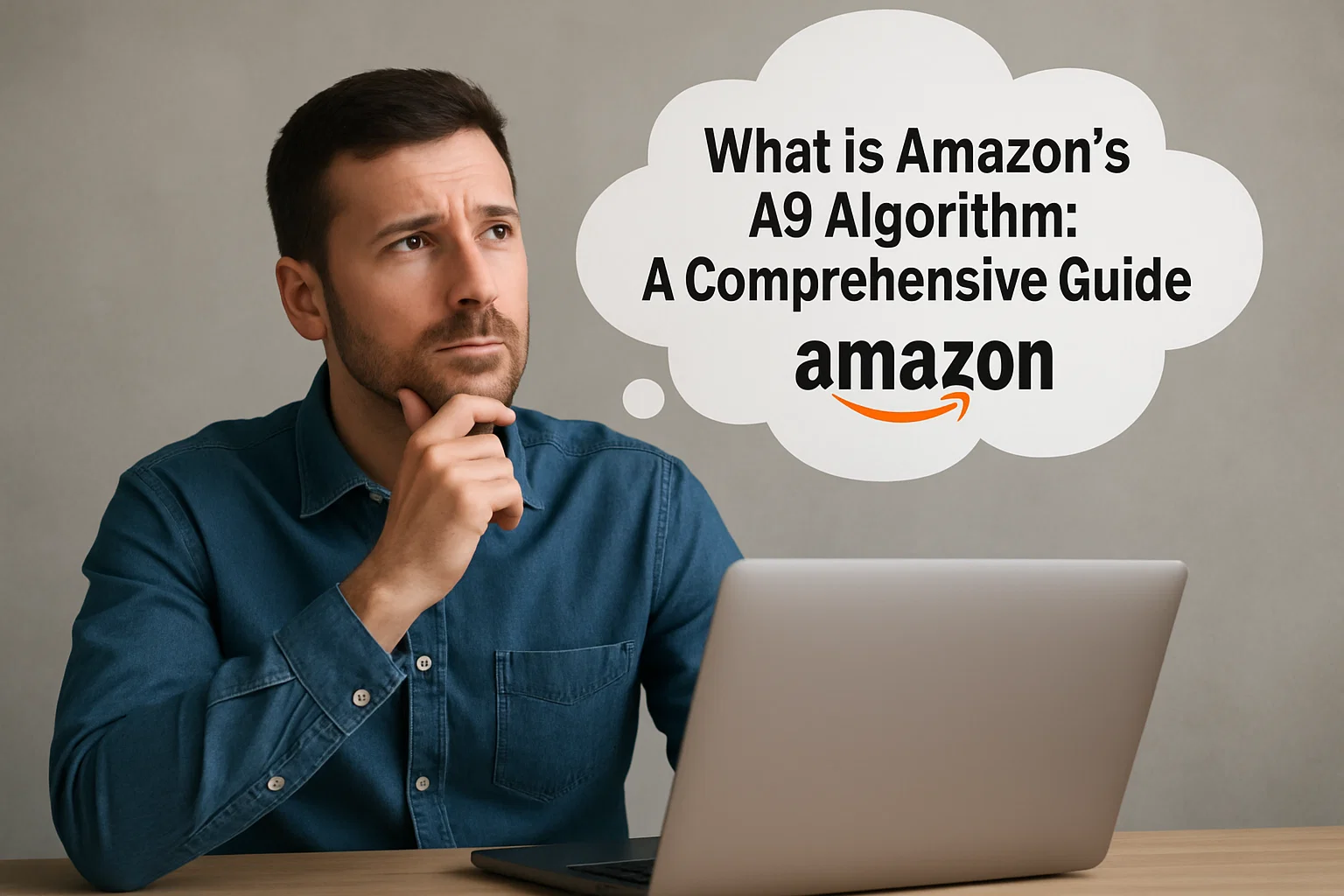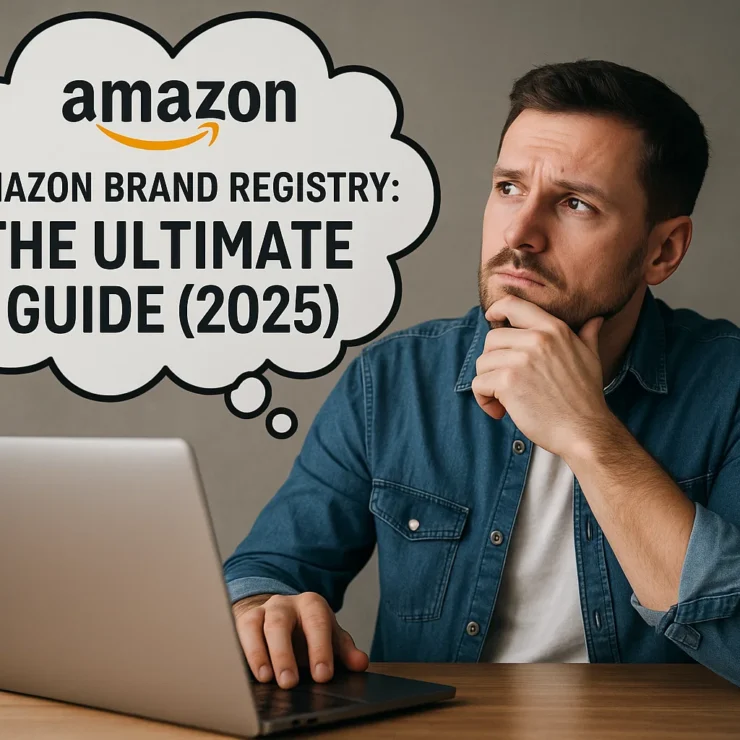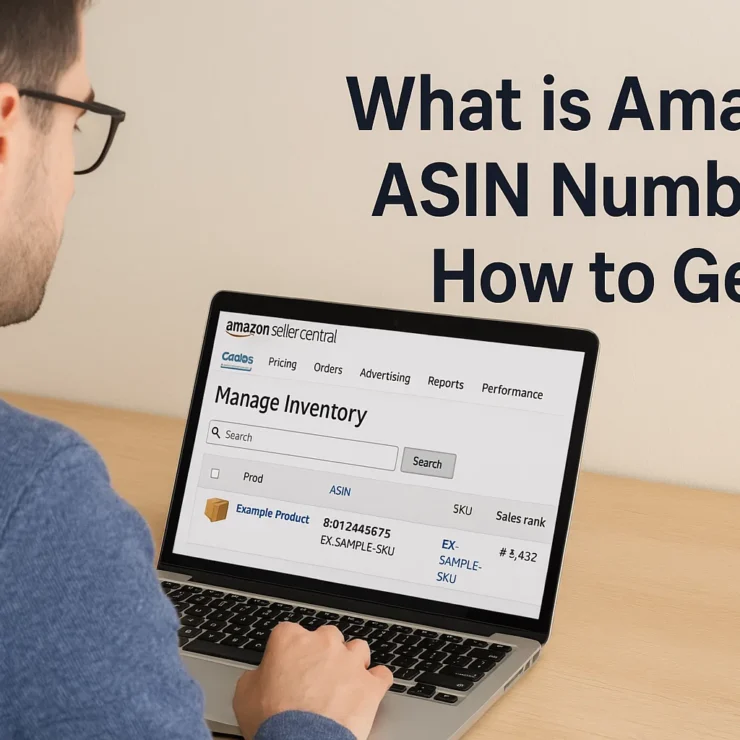If you’re an Amazon seller, there’s one thing standing between your product and your customer: Amazon’s A9 algorithm.
Amazon’s A9 powers the search engine behind every query typed into the Amazon search bar. It decides which products show up, in what order, and—most importantly—which listings get clicks, conversions, and sales. In 2025, as Amazon continues to refine its search system using AI and performance-based data, mastering the A9 algorithm is no longer optional—it’s essential for success.
In this in-depth guide, you’ll learn:
What the Amazon A9 algorithm is and how it works in 2025
Which ranking factors matter most today
The differences between A9 and Google’s search system
How to optimize your listings for better rankings and conversions
Tools and strategies to track your Amazon SEO performance
Whether you’re a seasoned Amazon seller or just scaling up, this guide will give you clear, actionable insights to help you rank higher, sell more, and outsmart the competition on Amazon.
Let’s dive in.
Building your own Amazon Storefront is a great way to showcase products and create a unique shopping experience. Learn how to create amazon storefront (2025 Guide).
What Is Amazon’s A9 Algorithm
To begin understanding Amazon SEO, you first need to get familiar with what Amazon A9 actually is. The Amazon A9 algorithm is the search engine behind how Amazon decides which products appear first when a customer searches for something on the platform. You can think of it as Amazon’s version of Google Search—but with a heavy emphasis on sales performance rather than just displaying information.
Just like Google, Amazon’s algorithm analyzes keywords to determine relevance. When a user types in “wireless earbuds,” the A9 algorithm scans millions of listings to figure out which ones most closely match that search term.
However, there’s one major difference: while Google’s goal is to give users the best possible content, Amazon’s goal is to make a sale. That means the Amazon search ranking algorithm doesn’t just care about how relevant your product is—it also takes into account how well your product performs when shown to customers.
In other words, conversion rate matters—a lot. If your product gets clicks and sales after appearing in search results, Amazon sees that as a signal that it’s useful to buyers. As a result, A9 boosts that product higher in rankings. If it doesn’t perform well, it will gradually drop down in visibility.
This creates a snowball effect: products that rank higher tend to get more visibility, which brings in more traffic, leading to even more sales—and so their rankings improve even further. On the flip side, listings that fail to convert can quickly get buried under the competition.
That’s why understanding and optimizing for the Amazon A9 algorithm is so important. You can’t just think about keyword stuffing anymore—you need to focus on how to make your listing convert. We’ll walk through that in more detail later, but just remember: Amazon rewards listings that sell.
If you’re new to selling, it’s helpful to know what an Amazon ASIN number is and how to find it.
What Factors Does the Amazon A9 Algorithm Consider to Rank a Product?
Understanding what the Amazon A9 algorithm looks for is key to boosting your product visibility on Amazon. Unlike traditional search engines, Amazon’s primary goal is to maximize sales per search—so A9 ranks products based not only on relevance but also performance.
Let’s break down the most important ranking factors that A9 considers:
Keyword Relevance (Content-Based Factors)
Amazon’s A9 algorithm evaluates how well your product listing aligns with a shopper’s search terms. Embedding relevant keywords across vital elements—like your product title, bullet points, description, and backend search terms—signals to A9 that your product matches the search intent. Avoid stuffing keywords unnaturally—clarity and flow are just as important as optimization. Effectively incorporating your search terms means your listing stands a better chance of being included in relevant searches. The algorithm looks for genuine alignment with shopper queries—not just frequent word repetition.
Sales Velocity (Conversion-Based Factor)
Sales velocity is essentially how quickly and consistently your product sells over time. Amazon’s A9 algorithm favors listings that not only rank well but convert buyers efficiently. Listings with brisk and steady sales indicate to Amazon that customers find them appealing and trustworthy. As a result, products with high sales velocity are more likely to climb in organic rankings, reinforcing a positive feedback loop. Sellers aiming for visibility must emphasize maintaining solid sales performance—not just relevance.
Click-Through Rate (CTR)
Your product’s click-through rate reflects the percentage of users who click on your listing from search results. A high CTR tells A9 that your title, image, price, or star rating stands out to customers browsing similar items. If shoppers ignore your product, Amazon interprets it as less engaging—even if you’re keyword optimized. Improving CTR often involves sharpening your main image, headline, and price point. When you attract more clicks, you enhance both your listing’s visibility and its performance signals.
Pricing Strategy
Amazon’s A9 considers how your product’s price compares to similar offers. Competitive pricing—without sacrificing margins—can translate into improved visibility and conversion. Price discrepancies that make your item seem costly, without clear value justification, can hurt rankings even if listing content is great. Dynamic pricing strategies—based on competition, seasonality, or demand—can help you stay relevant and profitable. A balanced, compelling price is a cornerstone of Amazon SEO success.
Stock Availability
Nothing gets punished faster than going out of stock. A9 disfavors listings that are frequently or suddenly unavailable, strafing them down search results. Sellers must manage inventory proactively to avoid interruptions. Listings consistently in stock send the message that you can fulfill orders reliably. That reliability favors your organic rank. Ensure inventory stability for your best-performing listings—and stay visible to buyers and the algorithm alike.
Customer Reviews and Ratings
High-quality reviews and strong ratings are social proof that build credibility. A9 values products with consistent, positive customer feedback. If buyers see favorable reviews, they’re more likely to click and purchase—boosting your CTR and conversion rate. Take proactive steps: deliver excellent customer experiences, solicit honest feedback within Amazon guidelines, and respond to concerns promptly. A listing with a higher aggregate rating stands a better chance of ranking well.
Product Images and A+ Content
Well-designed visuals drive conversions—and A9 likes what converts. Listings with multiple clear, lifestyle-supporting images, and enhanced A+ or Premium Content (for brand-registered sellers), help users understand product features and benefits. That leads to longer time on page, fewer returns, and better conversion metrics. A9 interprets engagement as trust, and trust deserves visibility. Boost your imagery and content quality to elevate both buyer experience and performance metrics.
Looking for more flexible fulfillment options? Check out some of the best Amazon FBA alternatives available in 2025.
How to Optimize Your Amazon Listings for the A9 Algorithm
To rank higher on Amazon, it’s not enough to just have a great product—you need to speak the A9 algorithm’s language. Since A9 rewards listings that are relevant, high-converting, and consistently available, your job as a seller is to ensure every part of your listing supports these goals.
Below are key areas you should focus on when optimizing your Amazon listings for A9:
Use Strategic Keywords in the Right Places
A9 can’t rank your listing for a search term if it doesn’t know your product is relevant to it. That’s why keyword placement matters just as much as keyword research. Your most important keywords should appear in:
Product Title: Include primary keywords early, along with brand, quantity, and core product type.
Bullet Points: Use bullet points to add supporting keywords and highlight features/benefits.
Product Description: Naturally include long-tail keywords and answer potential customer questions.
Backend Search Terms: Use all available character space—avoid repeats and include synonyms, spelling variants, or regional terms.
Optimize Product Titles
Your product title is one of the most weighted elements for A9—and it also drives your CTR. A well-optimized title should:
Begin with the brand name (if known)
Include your primary keyword as close to the beginning as possible
Clearly state what the product is
Mention size, color, or quantity if relevant
Example:
Poor Title: “Shoes for Men, Casual”
Optimized Title: “Nike Men’s Running Shoes – Lightweight, Size 10, Black – Comfortable & Breathable”
Stay within Amazon’s character limits (generally 200 for most categories) and don’t keyword-stuff. Make it readable and compelling.
Craft Benefit-Driven Bullet Points
Bullet points are your chance to sell the product’s value—not just describe features. A9 reads these to understand relevancy, while shoppers scan them to decide if your product is right for them.
Begin each bullet point with a capitalized benefit (e.g., “COMFORTABLE FIT – Designed for all-day wear”)
Include supporting keywords naturally
Use 5 bullet points, each with a unique angle (use case, benefit, material, quality, etc.)
Focus on buyer concerns (durability, compatibility, usability)
This combination improves conversions—which in turn boosts your A9 rank.
Curious about product rankings? Understanding what Amazon BSR means can help track performance more effectively.
Write a Persuasive, Informative Product Description
Though less important than bullets or title for A9, your product description matters for conversions and mobile shoppers. It’s also indexed by A9 and can improve long-tail keyword relevance.
Tips for effective product descriptions:
Use short paragraphs, headers, and spacing to improve readability
Emphasize emotional and practical benefits
Answer common objections or FAQs
Highlight brand values, guarantees, or certifications
Brand-registered sellers should also use A+ Content here to enhance visuals and storytelling—this doesn’t directly affect SEO, but it dramatically improves conversions, which A9 rewards.
Improve Your Product Images
While A9 doesn’t “see” your images, it notices what your customers do with them—zooming, scrolling, or clicking.
Use a high-resolution main image with a white background (at least 1600×1600 pixels)
Include 6–9 secondary images showing different angles, uses, or lifestyle contexts
Add infographics to explain size, features, or compatibility
Consider video to boost engagement and conversions
The better your imagery, the more clicks and conversions you’ll get—which A9 directly values.
Keep Pricing Competitive and Transparent
A9 favors listings that convert—and overpriced products typically don’t. Use repricing tools or manual strategies to ensure your offer is competitive in your category.
Monitor your competitors’ pricing daily
Consider offering bundles or discounts to increase perceived value
Use coupons, lightning deals, or Prime-exclusive deals to stand out in search results
If you’re using Fulfillment by Amazon (FBA), your pricing strategy becomes even more powerful because you’re combining competitive prices with Prime shipping—something A9 loves.
What is the difference between Amazon A9 and A10 algorithms?
Amazon A10 is seen as an upgraded version of the A9 algorithm, even though Amazon hasn’t officially confirmed the name. A9 focused mainly on sales performance, ad spend, and keyword relevance. If your product sold well through Amazon ads, it ranked higher.
But A10 brings a big shift. It now prioritizes seller authority, external traffic, and organic performance more than before. That means Amazon wants to reward trustworthy sellers who bring value — not just those who spend the most on ads. It also gives more weight to off-Amazon traffic, like visitors from social media or blogs.
While sales history and keywords still matter, A10 is more focused on long-term customer trust, brand credibility, and how well your product performs without relying only on ads.
Stay competitive in pricing with this list of the top Amazon repricer tools for sellers in 2025.
Conclusion
Understanding how the Amazon A9 algorithm works is essential for every serious Amazon seller in 2025. While the core of A9 still focuses on relevance and performance—such as sales history, keyword optimization, and click-through rate—Amazon’s evolution into the A10 algorithm emphasizes trust, seller authority, and off-site traffic.
To stay competitive, sellers must go beyond just running PPC campaigns. They should invest in organic strategies, build a strong brand presence, maintain stellar customer service, and actively drive traffic from external sources.
By mastering both A9 and the newer ranking signals from A10, you’ll not only improve your visibility but also boost sales, customer trust, and long-term growth on Amazon.
Thinking about launching your own brand? Here’s a complete guide to starting a private label business through Amazon FBA.
FAQ's
What is the Amazon A9 search engine and how does it work?
Amazon A9 is the algorithm that determines how products are ranked in Amazon’s search results. It works by analyzing factors like keyword relevance, sales performance, click-through rate, and conversion rate. The better your listing performs in these areas, the higher it appears in search results.
How can I optimize my product listings for Amazon's search engine?
To optimize your listing for the A9 algorithm, focus on:
Relevant keywords in your title, bullets, and backend.
High-quality images and compelling copy to boost conversions.
Positive reviews and fast, reliable shipping.
Competitive pricing and strong seller metrics.
Together, these help increase visibility, clicks, and ultimately, sales.
Is A9 owned by Amazon?
Yes, A9 is a subsidiary of Amazon. It was developed to power the company’s product search engine and advertising technology. The A9 algorithm helps match customer search queries with the most relevant product listings on Amazon.
What is the A10 algorithm on Amazon?
The A10 algorithm is considered the evolved version of A9, though Amazon hasn’t formally named it that. A10 still considers core A9 factors but puts greater emphasis on:
Seller authority
Organic sales
External traffic
Customer satisfaction metrics
This shift means sellers must focus on building trust and long-term value, not just paid ads.
What affects Amazon ranking?
Amazon rankings are influenced by:
Sales velocity
Keyword relevance
Conversion rate
Click-through rate (CTR)
Customer reviews
Fulfillment method (FBA often ranks better)
Inventory health
External traffic
Each of these factors signals to Amazon whether your product is worth showing higher in search results.
Power Your Brand. Automate Your Growth. Win on Amazon — with Stores Automation
Ready to transform your Amazon store and achieve big wins. Sign Up at Stores Automation for personalized solutions that leverage the power of automation for your business. Reach out to us at 302-204-8244 or via email at info@storesautomation.com. For more information, visit our Contact Us page. Embark on the path to e-commerce success with Stores Automation – where small changes lead to big wins!





